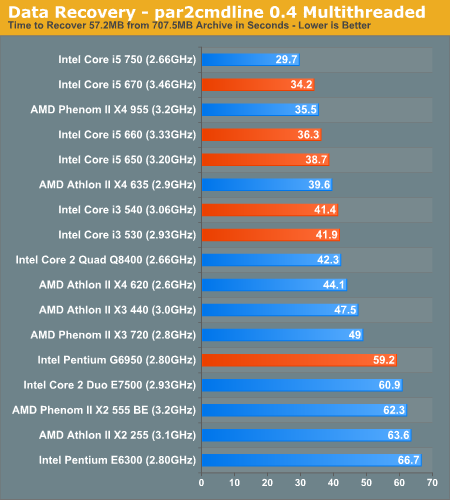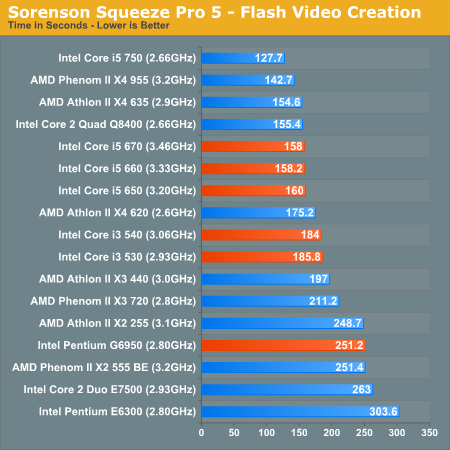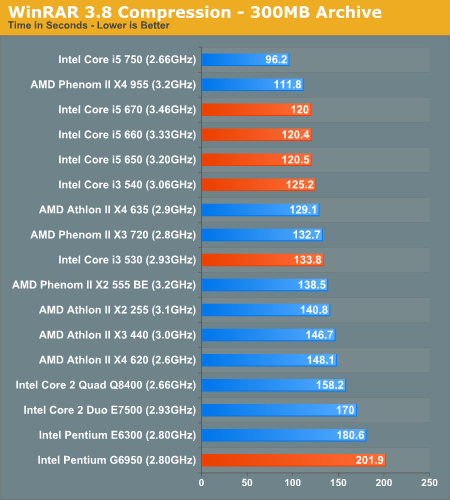The Rest of Clarkdale: Intel's Pentium G6950 & Core i5 650/660/670 Reviewed
by Anand Lal Shimpi on March 24, 2010 4:00 PM EST- Posted in
- CPUs
PAR2 Multithreaded Archive Recovery Performance
Par2 is an application used for reconstructing downloaded archives. It can generate parity data from a given archive and later use it to recover the archive
Chuchusoft took the source code of par2cmdline 0.4 and parallelized it using Intel’s Threading Building Blocks 2.1. The result is a version of par2cmdline that can spawn multiple threads to repair par2 archives. For this test we took a 708MB archive, corrupted nearly 60MB of it, and used the multithreaded par2cmdline to recover it. The scores reported are the repair and recover time in seconds.

Our Par2 test scales very well with core and thread count, which is why the Core i5 750 does so very well here. The Pentium G6950 does well against AMD's dual core options, but against the triple core Athlon II X3 440 it doesn't stand a chance.
Sorenson Squeeze: FLV Creation
We're using Sorenson Squeeze to convert regular videos into Flash videos for use on websites.

WinRAR - Archive Creation
Our WinRAR test simply takes 300MB of files and compresses them into a single RAR archive using the application's default settings. We're not doing anything exotic here, just looking at the impact of CPU performance on creating an archive:

The Pentium G6950 does horribly here, worse than the Pentium E6300.










70 Comments
View All Comments
Teloy - Friday, March 26, 2010 - link
"It's GPU still only runs at 733MHz though"... "It's" is not quite right... Take care.8steve8 - Thursday, March 25, 2010 - link
why was the G45 omitted on pg2 in the graph of power consumption under load with integrated graphics?I was keen to see how much more efficient HD graphics were than g45.
-stephen
bpdski - Thursday, March 25, 2010 - link
It would have been nice to see the benchmarks run with the overclocked G6950 also.- Brian
Taft12 - Thursday, March 25, 2010 - link
I have a hard time comprehending what Intel/AMD's TDP ratings mean in light of the "Load Power Consumption" graph.How is it that Intel CPUs with higher TDP ratings consume MUCH LESS power at load than AMD CPUs with lower TDP ratings. Just looks at the results -- all of the Intel core i3/5 CPUs are 73W TDP but the Athlon X2 255 is rated at 65W yet consumes 20 more watts at load. Is the 790FX motherboard that inefficient? WTF???
Lower idle consumption for Intel I understand due to the smaller process and excellent design, but do the TDP ratings truly mean nothing? This is a disastrous result for AMD.
strikeback03 - Friday, March 26, 2010 - link
Both companies rate their TDP differently, and in either case it is not designed to be a measure of power consumption.Nickel020 - Thursday, March 25, 2010 - link
It would be nice if you could include the 661 in the power consumption charts. Does its higher TDP actually lead to higehr power consumption?Sunburn74 - Thursday, March 25, 2010 - link
If you're gonna talk about the value of a 4.4 ghz overclocked processor, you gotta include it the benchmarks. Duh!crochat - Thursday, March 25, 2010 - link
Why the hell is it necessary to always put discrete graphics card in systems with integrated graphics and do power consumption tests with it? Is the benchmark used for power independent from the graphics card?I understand that it is much simpler to measure watts only, but what is important is the resulting task energy consumption, taking into account the efficiency of the processor..
strikeback03 - Friday, March 26, 2010 - link
Because some of the tested systems don't have integrated graphics. So for the application performance comparisons shown to be valid, the discrete GPU has to be kept in there. Wouldn't want someone thinking they could get 69.1 FPS in Crysis Warhead with the power consumption of only the integrated graphics.Taft12 - Thursday, March 25, 2010 - link
It's necessary to save many hours of work the testers could spend on more articles. What counts is the delta in power consumption between CPUs/platforms at idle and load.I'm an AMD fan, but the bottom line is Intel systems are more power efficient, period.